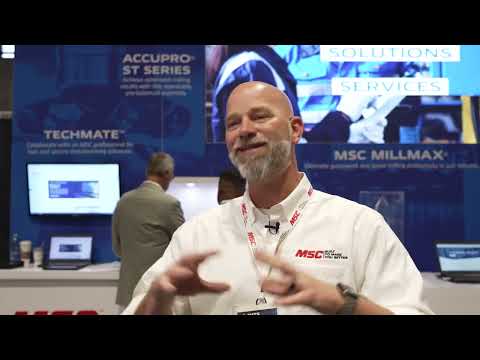IMTS Insights: Using Technology to Counter the Machinist Shortage
As manufacturers and machine shops ramp up recruitment and training to address a worsening shortage of qualified workers, they’re also leaning into technology for workarounds.
As manufacturers and machine shops ramp up recruitment and training to address a worsening shortage of qualified workers, they’re also leaning into technology for workarounds.
With machine shops and manufacturers grappling with a workforce shortage expected to reach 2.1 million jobs by 2030, demand for technological advances that can blunt the impact is rising faster than ever.
And the U.S. industry is responding, with next-generation cutting tools, robotics, wireless measuring devices and digital twins, an array of which are showcased at IMTS 2022, North America’s largest manufacturing technology trade show, this week in Chicago.
“You have to make manufacturing cool again,” says Gene Granata, director of product management at CGTech, who discussed leveraging technology to counter the shortage of qualified workers during a presentation at the weeklong event. “We’re not at the bottom of this curve yet, and we need to make parts better, cheaper and faster.”
Not only are 5 million fewer Americans employed in manufacturing now than 20 years ago, but nearly 600,000 positions were lost during the past two years, Granata says, citing a variety of reports.
While employers are pushing back, intensifying recruitment efforts and teaming with community colleges and technical schools to build the U.S. workforce, the payoff from those efforts will take years.
“Building talent pipelines is a process, not a light switch,” Granata says.
Improved machining technology, however, can help machine shops survive rising labor, materials and equipment costs in the meantime by enabling smoother job runs, higher feed rates, longer tool life and shorter cycle times, says Granata, whose Irvine, California-based employer developed Vericut software, an industry standard for CNC simulation and tasks including optimization and verification.
CGTech employees demonstrated the latest release, Vericut 9.3, at IMTS, working with partners to show the software’s capabilities and how it works in a machine operation.
“We see the huge gains that companies make when they embrace the concept of using machine data as part of their daily routine,” Josh Davids, president of Scytec, explained in a statement. His company teamed with CGTech to develop the new CNC Machine Connect module, which lets users link Vericut directly to CNC machines so they can access real-time data from shop floors.
IMTS 2022: See the MSC Innovations Amping Up Machine Shop Performance

“Combining machine connectivity and data with Vericut truly brings the value of machine monitoring and digital twin technology to a new level, which is unmatched in the manufacturing industry,” Davids said.
By boosting productivity, such advances also help curb the pain of rising inflation, a core measure of which reached 6.3 percent in August, as well as supply-chain disruptions that have slowed production since 2020.
Both trends have exacerbated the challenge from the shrinking industrial workforce that’s being fueled by two simultaneous developments. A 2021 study by Deloitte predicted 1.5 million new jobs in manufacturing over the next decade as well as 2.5 million retirements.
“One of the things we can do is figure out how can we do more magnitude of what we already are pretty good at and do it even more efficiently or better or with less resources,” Granata says. “We can use technology to do this kind of stuff.”
Software, for instance, can be used to avoid what Granata dubbed the classic “wash, rinse and repeat” cycle for part prove-outs: CNC programmers writing a program to build a part, then sending it to the shop floor for a machinist to execute, trouble-shoot and return it to the programmer for needed revision.
Using a platform such as Vericut can allow programmers to weed out many of the potential problems before the program is sent to the shop floor the first time, he says, leading to significant improvements in productivity.
WATCH: Norton Revolutionizes Grinding with Quantum Prime
Enhancements in cutting tools like the Quantum Prime wheel from Norton, new lubricants such as the HyperSol 888NXT from Master Fluids and digital metrology tools such as MeasurLink from Mitutoyo, also optimize machine shops, enabling them to accomplish more with their existing workforces.
“We’re constantly looking at new products that are going to help our customers make more parts faster,” says John Treese, director of global training for Master Fluid Solutions.
“A lot of times, companies are running on skeleton crews,” adds Hany Abdel-Motaleb,” national data management and MeasurLink sales engineer at Mitutoyo.
WATCH: Breakthroughs from Master Fluid Solutions and Mitutoyo Turbocharge Machine Shops
MeasurLink helps with that dilemma by taking data from inspection tools and funneling it into a centralized location where engineers, quality managers and production managers alike can analyze the information and devise ways to trim costs, improve operations and increase output.
Businesses want to be able to “push the button and push parts out the door,” Abdel-Motaleb says, “and with our data-management tools and accessories, they can do exactly that.”




